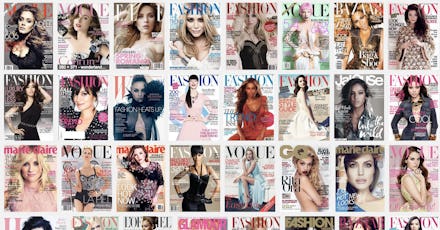Science Explains Why Women Buy Magazines That Can Make Us Feel Bad

It's been argued over and over that looking at "classically" beautiful — in other words, thin and fair-skinned — models in media, particularly fashion magazines, makes women feel crappy about their own bodies. So why do we keep buying the magazines?
Looking at 51 college-aged women, the study examined how models in magazines made participants feel about their own bodies. When asked to simply assess the models in contrast with themselves, answering with statements like "This woman is thinner than me," the participants were less happy.
But when they were prompted to evaluate the models in a context of self-improvement, answering questions with statements like, "I would like my body to look like this woman's body," the participants actually felt increased body satisfaction.
The word used by co-author Silvia Knobloch-Westerwick, a professor of communication at OSU, is "thinspiration." While the term sounds pretty, anyone who's stumbled into the depths of Instagram, Tumblr or pro-anorexia blogs knows how insidious it is. The unhealthy thinspiration movement is powered by young women aspiring to get thinner through the "thinspo" images around them — including those pulled directly from fashion magazines.
Research like the OSU study confirms the sneaky power of thinspiration, demonstrating how skinnier-than-thou bodies actually make us feel optimistic, motivated and positive. That feeling, Knobloch-Westerwick points out, is dangerous: "It makes them feel better at first, but in the long run women are buying into these thinness fantasies that just won't come true."
They won't come true, in part, because models' bodies are far outside the norm. According to a 2013 survey of over 5,000 American women, more U.S. women report wearing a size 16 than those who wear a size 0 and size 2 combined. But most fashion models are size 0 or 2, with a 4 pushing the limits of acceptability. (Once models edge above a size 6, they're usually designated as "plus-size.")
It's important to remember, however, that it's not just the models' actual bodies that set unrealistic goals for women. As Keira Knightley reminded us in a recent topless shoot for Interview, celebrities and models often have their bodies manipulated by Photoshop, digitally earning bodies even they couldn't attain in real life.
"I think women's bodies are a battleground and photography is partly to blame," the British actress told the magazine. These days, with more photos flashing before us than ever, "it becomes more difficult to see all of those different varieties of shape."
But showcasing those true-to-life varieties is crucial. As the Ohio State study highlights, the images women see can be seductive inspirations. What we need are more images that remind us that we're beautiful just the way we are.